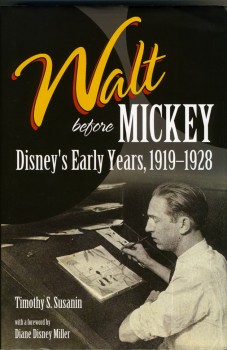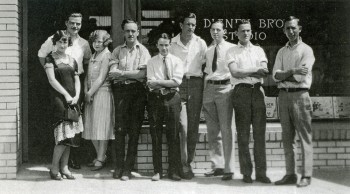Animation Artifacts &Books &Commentary &Disney 11 Aug 2011 06:52 am
Response
- On Tuesday, I’d posted a review of Timothy Susanin‘s excellent book, Walt Before Mickey: Disney’s Early Years 1919-1928. I loved the book and, in fact, worried that I was being too critical. I did tend to go on quite a bit about the details on details within the book.
To my surprise I’d received an email response from Mr. Susanin, and I asked him if he would mind my posting his letter. He immediately gave me permission and here’s his response to my review:
 Dear Mr. Sporn,
Dear Mr. Sporn,
Many thanks for reading my book; for writing a review; and for your kind words.
I can’t tell you how much fun I had learning the story of Walt’s first decade. It was a most enjoyable and unexpected hobby, and I am sorry it’s over!
I am biased about Walt, of course, so I found the subject matter thrilling and a page turner, like you.
Your review is dead on in a number of respects. I am a Disney fan, not an animation expert, thus I was not equipped to search for the art, as were J.B. and Russell. Being a lawyer who has done many investigations, and written many detailed factual reports based on investigations, I was simply all about finding out what happened during Walt’s “missing decade.”
There was a reference in the Laugh-O-gram bankruptcy file to a studio “minute book,” and I would have been thrilled had a daily diary of any or all of that decade still existed! For me, following Walt day by day was the way to learn the real Walt and to see how he really got started.
So for me, a novice author and biographer — and maybe this notion would not be acceptable to other, experienced authors and biographers — there was real worth in learning all of the detail you mention in your review. Because no daily account existed, trying to find out at least what he was doing on a monthly basis helped bring this period alive for me.
The overload of detail — again, for me — allowed the physical spaces he occupied, the friends and colleagues, the look and feel of the period, the films produced to all come together and create a real portrait of that missing decade.
I agree that the question is: is this a viable biography for others outside this “niche market?” I didn’t set out to write a book, and once a book resulted, it was the book I would have wanted, because of the level of detail I wanted to know in order to really learn that period of Walt’s life. So, it worked for me!
And, as you point out, there were limitations. I had no budget. I had no publisher until the book was finished. I was not sure until near the end of the process that the Disney Company would provide photos.
So….this was very much a project where I was limited to take what others had done
and try to build on it, add facts to it, string things together, on my own and in my
spare time —- evenings and weekend.
I pulled all this together to learn about Walt in the 1920s. The info turned into a timeline that turned into a more detailed chronology that turned into a book. Along the way, I tried to find answers to whatever questions I had so that the blanks could be filled in.
I think what resulted is a work that I would have loved to come across in a book store or in a library, along with the realization that others would feel the same way, but maybe not a lot of others!
 In the end, I got a real sense of who Walt was; what the first ten years of his career were like; how they set the stage for the rest of his career; and how a lot of his original collaborators fit into the big picture. It really sets the table nicely for me to now go on and read and learn about Walt in the 30s, 40s, etc.
In the end, I got a real sense of who Walt was; what the first ten years of his career were like; how they set the stage for the rest of his career; and how a lot of his original collaborators fit into the big picture. It really sets the table nicely for me to now go on and read and learn about Walt in the 30s, 40s, etc.
Unlike you, I did not want the book to go on. After six years and many rewrites and endless proofreading, I wanted it out the door and almost got sick of it! Maybe you can predict what happened after that: I now find myself wondering with increasing frequency about the spring of 1928, and what happened —- in a detailed way, on a daily or monthly basis! —- as Mickey appeared on the scene.
I thought that I would have nothing further to contribute to the Disney canon because, from Mickey’s appearance in 1928 til today, enormous amounts have been written about Walt’s story. Unlike the “missing decade” of the 1920s, the record is complete as far as the other decades of Walt career are concerned.
And yet….I find myself getting the urge to dig into the spring of 1928 and see where that takes me.
I don’t really know if I have another book in me, but my mind is starting to wander in that direction. I’ll keep you posted!
Many thanks again for your interest and your review.
Boy, do I hope he comes up with something about those several months between the start of Plane Crazy and the premiere of Steamboat Willie. Can you imagine the pressure on Walt and Roy? They’d just been robbed of their staff and had lost a semi-lucrative job doing Oswald cartoons. They create a mouse character, and no one wants the first short. So they do a second film starring Mickey, and still they can’t sell it. They do a third one trying to capitalize on the incoming sound transition. They show the film at one theater – for free – just to get it in front of an audience. Success! That short period is a tale in its own, and it’s never really been covered by writers.
In the photo, above: LtoR – Irene Hamilton (Inker), Rudy Ising, Dorothy Manson (Inker), Ubbe Iwerks, Rollin Hamilton, Thurston Harper, Walker Harman (Inker), Hugh Harman, Roy Disney. Walt took the photo.
On to something else that’s related. Mark Sonntag on his extraordinary blog, Tagtoonz, has posted some rarely seen photos of the first days of Disney’s filming in Kansas City. After posting the one photo of Walt directing and Red Lyon filming the Cowles children in 1922, he was contacted by a member of the Cowles family, and they offered additional photos. Take a look.
